|
|
 |
Fiche d'espèce de Copépode |
|
|
Calanoida ( Ordre ) |
|
|
|
Spinocalanoidea ( Superfamille ) |
|
|
|
Spinocalanidae ( Famille ) |
|
|
|
Mimocalanus ( Genre ) |
|
|
| |
Mimocalanus nudus Farran, 1908 (F,M) | |
| | | | | | | Syn.: | Mimocalanus sulcifrons (M) : Wheeler, 1970 (p.7, figs.M) | | | | Ref.: | | | Farran, 1908 b (p.24, Descr.F, figs.F); Sewell, 1948 (p.483); Farran & Vervoort, 1951 h (n°40, p.3, figs.F); Grice & Hulseman, 1965 (p.223, 227, figs.M, Rem.M); Damkaer, 1975 (part., p.69, figs.176, 178-180); Brodsky & al.,1983 (p.307, figs.M, Rem.F,M); Vives & Shmeleva, 2007 (p.825, figs.F,M, Rem.); Bode & al., 2017 (p.600, Table I, III, fig. 2, 3, 4, morphology vs genetic). | 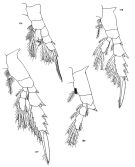 issued from : D.M. Damkaer in NOAA Technical Report NMFS CIRC-391, Seattle, 1975. [p.71, Fig.176, 178-180]. Female: 176, P1; 178, P2; 179, P3; 180, P4.
|
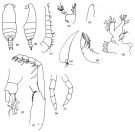 issued from : G.D. Grice & K. Hulsemann in J. Zool., 1965, 146. [p.228, Fig.6, a-l]. Male (from NE Atlant.): a, habitus (dorsal); b, idem (lateral left side); c, proximal portion of A1; d, sensory filament from A1; e, Md (mandibular palp); f, Md (end of the masticatory blade); g, Mx1; h, Mx2; i, Mxp; j, P1 (2nd and 3rd exopod segments missing); k, right P5; l, left P5. Nota: Head and 1st thoracic segment separate, 4th and 5th separate. Proximal segments of A1 with sheath-like sensory filaments. Left and right P5 (5-segmented) equal.
|
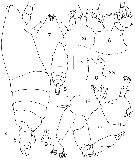 Issued from : E.H. Wheeler, Jr in Smiths. Contr. Zool., 1970, 55. [p.17, Figs.5-12]. As Mimocalanus sulcifrons. Male (from 24°33'N, 69°30'W): 5, habitus (lateral); 6, forehead (ventral view); 7, idem (dorsal view); 8, habitus (dorsal); 9, P5; 10, Md (gnathal lobe); 11, Md (mandibular palp); 12, A2. Nota: - Lateral margin of 1st pediger segment minutely dentate. 4th and 5th pediger segments fused. - Posterolateral margins of 5th pedigerous segment broadly rounded. - Urosome of 5 subequal segments. - Rostrum absent. - Anterior portion of cephalosome appears bilobed, indented dorsally with rounded, V-shaped groove, bearing fine setae on interior sides. - A2 basipod with 1 proximal and 2 distal setae; exopod 7-segmented, segments 3-6 each bearing 1 seta, segment 7 with 1 lateral seta and 3 strong terminal setae; endopod 23-segmented, distal segment with 13 setae and a row of small spines along distolateral margin. - Md baseof palp with 2 setae; endopod 2-segmented, with 2 setae on 1st segment and 8 setae on terminal segment; exopod 4-segmented, with 6 setae; gnathobase reduced, with 2 blunt teeth. - P5 uniramous, 5-segmented; left leg slightly longer than right leg; terminal segment of left leg ending in 2 small points, that of tight leg in 1 small point
|
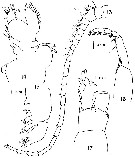 Issued from : E.H. Wheeler, Jr in Smiths. Contr. Zool., 1970, 55. [p.18, Figs.13-17]. As Mimocalanus sulcifrons. Male: 13, A1; 14, Mx1; 15, Mx2; 16, Mxp; 17, P1 (last 2 exopod segments missing). Nota: A1 24-segmented, segments 2-8 adorned with horn-shaped esthetes, extend 1-2 segments beyond caudal rami. - Mx1, 1st inner lobe reduced and devoid of spines or setae; 2nd and 3rd inner lobes bearing 1 and 2 setae respectively; 2nd basal segment with row of 4 sharp spines on distal inner margin; endopod with 9 setae; exopod with 10 setae. - Mx2 reduced, with 7 distincts lobes, proximal lobe without seta, remaining lobes with 2-3 setae each. - Mxp with elongate basipodal segments, each with 1 distal seta, anterior lateral margins of both segments of basipod with row of fine hairs on either side of their common articulation; endopod 5-segmented with 19 setae.
|
 Issued from : E.H. Wheeler, Jr in Smiths. Contr. Zool., 1970, 55. [p.19, Figs.18-20]. As Mimocalanus sulcifrons. Male: 18, P2 (rest of endopod and exopod missing); 19, P3 (idem); 20, P4 (idem).
|
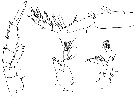 issued from : G.P. Farran in Fish. Ire. Sci. Invest., 1906, II [1908]. [Pl. I, Figs.1-4] . Female (from 55°0'N, 10°48'W): 1, P3; 2, A2; 3, Md (mandibular palp); 4, Mxp.
|
 Issued from : V.N. Andronov in Russian Acad. Sci. P.P. Shirshov Inst. Oceanol. Atlantic Branch, Kaliningrad, 2014. [p.44, Fig.12, 9]. Mimocalanus nudus after Damkaer, 1975. Female P1.
|
 Issued from : M. Bode, S. Laakmann, P. Kaiser, W. Hagen, H. Auel & A. Cornils in J. Plankton Res., 2017, 39 (4). [p.603, Table I]. Species identified via morphological and molecular analyses, including the number of specimens used for each identification method (MI: morphological identification, COI: cytochrome c oxydase subunit I gene fragment, MS: MALDI-TOF analysis, 18 S: ribosomal 18 S gene fragment). Cryptic lineages were revealed only after molecular analysis. Sampling depth, latitude, total length (TL) and Prosome/Urosome ratio (Pr:Ur) of taxon were recorded. morphological characters are only listed here, if the identification was ambiguous due to missing body parts or if cryptic or pseudocryptic lineages were revealed during molecular analyses. For diagnostic character of species refer to the references: Park, 1970; Grice, 1971; Damkaer, 1975; Schulz, 1989, 1996. C = coxa; End = endopodite; Exp = exopodite; P = swimming legs; Exp = exopod; End = endopod.
| | | | | Ref. compl.: | | | Grice & Hulsemann, 1967 (p.14); Park, 1970 (p.475); Roe, 1972 (p.277, tabl.2); Vives, 1982 (p.290); Lozano Soldevilla & al., 1988 (p.58); Holmes, 2001 (p.41); Schnack-Schiel & al., 2008 (p.1046: Tab.2); Medellin-Mora & Navas S., 2010 (p.265, Tab. 2) | | | | NZ: | 5 | | |
|
Carte de distribution de Mimocalanus nudus par zones géographiques
|
| | | | | | | | | | Loc: | | | Antarct. (W Weddell Sea), Canary Is., Caribbean Sea, Caribbean Colombia, G. of Mexico, off E Bahamas, off W Ireland, W Indian, E Atlant. (2°N) | | | | N: | 11 | | | | Lg.: | | | (13) F: 2,7-2,28; M: 2,5; (24) F: 2,64; (131) F: 2,64-2,1; M: 2,37-1,9; (199) F: 2,43-2,28; (203) M: 2,02; (1252) F: 2,40-2,58; {F: 2,10-2,70; M: 1,90-2,58}
(1252 )F: Pr/Ur = 3,5-4,0. | | | | Rem.: | bathypélagique.
Brodsky & al. (1983, p.307, Rem.: p.309) ne suivent pas la synonymie établie par Damkaer (1975, p.69, Rem.: p.72).
La présence de cette espèce à l'ouest de la Mer de Weddell (entre 500-1000m) est étonnante.
Voir aussi les remarques en anglais | | | Dernière mise à jour : 19/06/2023 | |
|
|
 Toute utilisation de ce site pour une publication sera mentionnée avec la référence suivante : Toute utilisation de ce site pour une publication sera mentionnée avec la référence suivante :
Razouls C., Desreumaux N., Kouwenberg J. et de Bovée F., 2005-2025. - Biodiversité des Copépodes planctoniques marins (morphologie, répartition géographique et données biologiques). Sorbonne Université, CNRS. Disponible sur http://copepodes.obs-banyuls.fr [Accédé le 17 août 2025] © copyright 2005-2025 Sorbonne Université, CNRS
|
|
 |
 |










